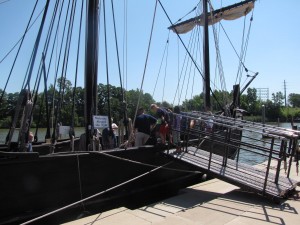 Why We Must Learn America’s Islamic History
Why We Must Learn America’s Islamic History
By Engy Abdelkader, 01/25/2012 11:00 am
…
“In 1492, Columbus sailed the ocean blue…” So we were taught in primary school. But, did you know that the captains of two of the three small Spanish ships comprising Columbus’s fleet were in fact Muslim?
Martin Alonso Pinzon the captain of the Pinta and his brother Vicente Yanex Pinzon the captain of the Nina helped organize Columbus’ voyages which introduced Europeans to the New World. The Pinzon brothers were in fact Muslims related to Abuzayan Muhammad III, a Moroccan Sultan.
I note this because American Muslims are often mispercieved as foreigners unwilling to assimilate. Yet, a survey of modern Islamic history and early American religious history reveals a uniquely different reality: the presence of Muslims in what would become the United States of America dates back to the earliest arrivals of Europeans in the Americas.
Some Muslims, such as Estevanico de Dorantes, arrived here as explorers. Originally from Morocco, in the 1550’s Estevanico was the first Muslim and the first African to travel to the continental U.S.
Many Muslims arrived here as slaves from Africa. In fact, scholars estimate that “tens of thousands” of African Muslims lived in colonial and antebellum America. During the 1730s, several such Muslims who were taken into slavery became well known.
Among them was Yarrow Mamout, for instance, an indentured servant in the South who was set free after he finished making all the bricks for a house his master planned to build. Mamout became a property owner, held stock in the Bank of Columbia, and even had his likeness painted by the famed artist Charles Wilson Peale in 1819 and again in 1822 by James Alexander Simpson.
Peter (Saleem) Salem is another such prominent American Muslim slave. Born into slavery in Massachusetts, Salem fought in the Revolutionary War and was subsequently honored for his valor. Specifically, he shot and killed British Major John Pitcairn when the colonial troops were near defeat and Pitcairn ordered them to surrender. In 1882, a gravestone monument was erected in his memory and he is also depicted in John Trumbull’s famous painting of the Battle of Bunker Hill.
Other Muslim slaves never had their likeness painted in such an illustrious fashion but they were featured in runaway slave advertisements. In fact, in September 1774, one such advertisement in the Savannah Georgia Gazette called for the capture of “Mahomet.” Another advertisement in the Gazette which ran in April 1789 sought the capture of “Amer.” In 1790, the Gazette also advertised about “Osman.”
An inextricable aspect of the American Muslim slave experience was their Islamic practice. Indeed, a number of Muslim slaves continued to worship the God of Abraham, Isaac and Jacob while toiling on plantations.
Job Ben Soliman, for example, was a Muslim slave who was known to “often leave the Cattle, and withdraw into the Woods to pray; but a white Boy frequently watched him, and whilst he was at his Devotion would mock him, and throw Dirt in his Face.”
Salih Bilali was a Muslim slave on a Georgia plantation who was described by his Master as a “strict Mahometan; [who] abstains from spirituous liquors, and keeps the various fasts, particularly that of the Rhamadan. He is singularly exempt from all feeling of superstition; and holds in great contempt, the African belief in fetishes and evil spirits.”
American Muslims have historically practiced their faith peacefully in the U.S.
Even more Muslims arrived in America in the 1700s, occupying diverse professions as teachers, cavalry leaders, religious leaders and students of law. Consider, for instance, Paul Cuffe who was a Muslim shipbuilder, captain and philanthropist. Cuffe’s family was originally from Ghana; his father’s name was Haiz (Saiz) Kofi. Cuffe was the first African American man to petition the U.S. government to free the slaves and to allow every African man desiring to leave America the opportunity to do so.
Ponder Hajj Ali, a native of Syria who was hired by The United States Cavalry in 1856 to experiment with raising camels in Arizona. He experimented with breeding camels in the desert and was a local folk hero in Quartzsite, Arizona, where he died in 1902.
Mohammed Ali ben Said, also known as Nicholas Said, is similarly worth referencing. Said fought in the American Civil War as a Union solider. Serving in Company 1 with the “55th Regiment of Massachusetts Colored Volunteers,” Said quickly rose from corporal to sergeant. According to his army records, he died in Brownsville, Tennessee in 1882.
And, then there is … well, I am sure you get the picture: American Muslims are an inextricable part of early American history even before our nation’s founding — an apt reminder to all those who use religion to sow hatred and division among us.
…
http://www.huffingtonpost.com/engy-abdelkader/americas-islamic-history_b_1228135.html?ref=religion or http://huff.to/x1daNz
Photograph: http://www.foreverforalwaysnomatterwhat.com/2011/08/nina-pinta-field-trip.html

1 comments
There is a monument to ” Hi Jolly ” as he became known in Quartzite.